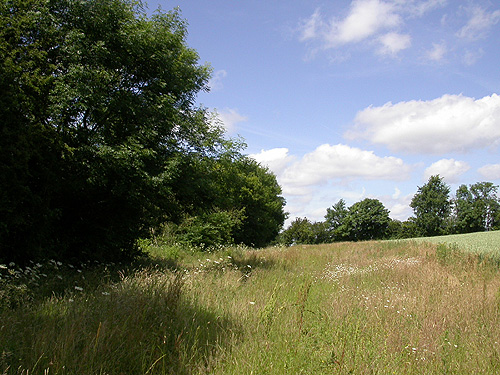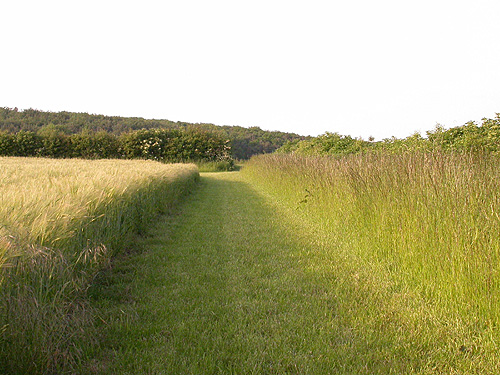

| The Stewardship set-aside strip scheme |
| More and more farmers are providing set-aside strips around many of their fields. Most of these are as a result of successful applications for available grants resulting from the Government's Stewardship Scheme. This recently updated page looks at the benefits to the area's wildlife since one Eakring farm's successful application back in 2002. | ||
| ..... | ||
| Set-aside strips
in the area Not until early 2002 had set-aside strips been instigated by any of the farms in the area, with most preferring the (then) traditional policy of herbicidal weed control by leaving a metre-wide boundary around crops. The set-aside strip system was first adopted by the Kingston Estate, leaving strips of land (uncultivated or sown with a suitable grass mixture) around many of it's fields around Hare Hill Wood and Kersall. This was largely done on a rental basis from other farms, in cases where they did'nt actually own the land. The system proved to be a viable one for the estate and had been introduced to benefit game-rearing around Hare Hill Wood and also help increase the numbers of breeding Sky Lark and a range of other farmland birds. The practice of managing the wood for the rearing of game helped to improve Hare Hill Wood's existing flora and fauna, when thinning work in Hare Hill Wood was carried out in the early part of 1999. |
 |
|
| ..... | ||
| This greatly
opened up some sections of the wood which had previously
suffered from severe canopy cover and allowed much of the
wood's former understorey to become re-established.
Although this thinning was primarily conducted for the
rearing of the Pheasants, much thought goes into the work
here, to create a balanced habitat which is also
beneficial to other wildlife. Permanent set-aside strips in use around the Kersall/Hare Hill Wood area, showed the first signs of success very quickly, with increased numbers of Linnet, Reed Bunting and Yellowhammer territories in the area within two years. The strips here vary, some consisting of rank grassland, whilst others have been left to self-seed and establish themselves naturally. This method has the advantage of providing suitable feeding areas for a different range of species. Eakring farm's successful application for Stewardship Scheme Grant Applicants for the grant have to follow strict procedures and during the application process, many farms fail to meet these and are ultimately unsuccessful. Out of every 30 applications, only two or three are apparently successful in obtaining grants. The deadline for applications is the end of May and reports are required to be of a certain quality. I was asked to compile this report for the farm concerned and helped in securing the grant required for the Scheme. Father and son farmers Michael and James Meanley of Ryall's Farm Eakring, were the first farmers in the area to apply for the Stewardship Scheme Grant back in 2002. In order to do this, they had to supply information about the existing wildlife their land supported and attracted, then file their application for assessment. I assisted them by producing a detailed report on the birds and insects that I had recorded on their land over the previous four years, dating back to 1998. They were eventually successful in receiving a grant to implement the scheme around a large area of their land. |
||
| ..... | ||
| Much of the land in
question, lies either side of the Eakring-Wellow minor
road around Lound Wood and Eakring Flash, running
alongside the old hedge and The Beck. A section of the six metre wide strip helps the fragile Water Vole population here, providing protection from spray-drift and mechanical disturbance. It has also allowed the gradual regeneration of many former hedgerow plants and provided increasing cover for birds, insects and mammals since. These strips also provide safe migratory corridors, along which wildlife can pass to allow the colonisation and recolonisation of other suitable areas. The grass strips are cut frequently during the Spring and Summer months, with half mown and kept short, whilst the other half is cut at the end of the Summer and used as a hay crop. All the strips are linked (with gates being horse friendly) and amount to nearly three miles of grassland/hedgerow habitat, accessible to the public. |
 |
|
| ..... | ||
| Part of the grant was allocated to the re-planting of hedgerows, thickening up old sections and filling in gaps. Many of these were filled using established Hawthorn plants, rather than single-stemmed ' whips'. Michael and James also made sure that Elders were retained within their hedgerows, rather than being removed. Hedgerows are generally cut every two years, or at least sections are cut on a rotational basis. | ||
| Set-aside strips and wildlife
2002-2007 Set-aside strips provide (not just new habitat) but migratory corridors, allowing species to pass through areas in order to expand and consolidate their local range and colonise potential new sites by providing a natural link between suitable areas. Their importance to wildlife cannot be over-estimated. The following section provides a brief insight into how the fortunes of the area's wildlife have changed. Birds Since 1998, numbers of over-wintering finches around Eakring Flash have always been very low. High numbers have occasionally occurred, but these have been quite rare and have coincided when whole fields have been used as set-aside. As yet, the area still contains no permanent habitat with an abundance of seed producing plants, capable of attracting and sustaining large numbers of finches and buntings through the Winter months. It was also hoped that the creation of these strips would also present an opportunity to encourage the recolonisation of the area by Barn Owls, by presenting suitable hunting habitat. Whilst Barn Owls have returned to one part of the Eakring and Kersall area and do use set-aside strips to hunt, it seems that the real problem around Eakring Flash/Red Hill is the present lack of any suitable nest site. Birds which have benefitted include Summer visitors like Whitethroat and Lesser Whitethroat, and farmland species such as Yellowhammer, Reed Bunting, Linnet and Grey Partridge. The general trend amongst many birds here, seems to be that most have been able to maintain breeding numbers, although in some cases this may not be eniterly attributable to set-aside strips alone. A breeding bird survey is to be carried out in 2008, to allow a ten year comparison in breeding populations from the original counts reached back in 1998. Butterflies, Moths and other insects Insects have probably benefitted most from set-aside strip introduction and there have been some notable range expansions here during the past four or five years. Unless a species is particularly habitat specific in it's breeding requirements, the strips have certainly helped to connect or create suitable breeding areas for butterflies such as the Brown Argus, Essex Skipper, Common Blue and Small Heath, but it is fair to say that all butterflies (with the exception of White-letter and Purple Hairstreaks) have increased in number and range since 2002 through the strips. |
||
| ..... | ||
| Many moths
have fared similarly. Grassland species like Latticed
Heath, Small Yellow Underwing, Straw Dot and a whole host
of micros are increasing, and many others look likely to
follow over the coming years. In June 2007, I recorded my
first Mother Shipton at Eakring Meadows, when the only
previous site I had seen them on here, was an area of
meadowland at Red Hill. Mammals Brown Hare is one of the most likely mammals to continue to do well under the set-aside scheme. Eakring and Kersall still holds a very healthy population, whilst new breeding areas have been created for voles, mice and shrews. |
||
| ..... | |||||||||||||
| Insects
showing an increase in records/numbers on set-aside
strips since 2002 The following insects have shown obvious increases in numbers, number of actual records, or have appeared in the area for the first time since 2002. All tend to favour grassland habitats. |
|||||||||||||
|
|||||||||||||
| Related pages | |||||||||||||
|
|||||||||||||